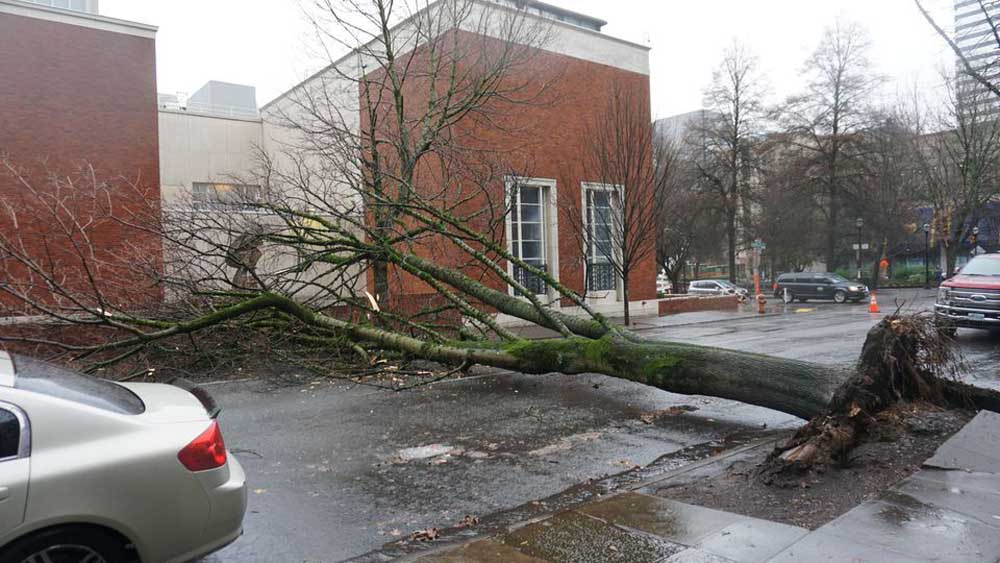PGE says $30 million repair bill for January storm will likely grow
Published 11:12 am Wednesday, February 14, 2024

- A downed tree blocks SW Jefferson Street near the Portland Art Museum in December.
Portland General Electric says it has spent more than $30 million on outage repair and restoration to recover from the weeklong ice-and-wind storm that swept the region in mid-January.
In a filing to Oregon’s Public Utility Commission, the investor-owned utility said the $30 million was an initial estimate that’s likely to increase as costs associated with additional restoration efforts continue.
PGE will eventually seek to recover those costs from customers — a lengthy process expected to take more than a year.
The commission will review PGE’s request to determine how much of the costs the utility can recover via a rate increase.
The $30 million represents about 1% of rates, said Bob Jenks, executive director of the Oregon Citizens’ Utility Board, a group that advocates for customers.
But, he said, if the estimate balloons — adding to other costs PGE seeks to recover from customers such as the cost of reducing the impacts of wildfires — the storm bill could lead to a higher rate increase.
The initial estimate spans PGE’s storm response from Jan. 13 to the Feb. 9 filing date, said PGE’s spokesperson Drew Hanson.
It covers materials to rebuild damaged poles and wires, additional workers and overtime from field crews, clearing downed trees to access and make repairs, mutual assistance costs and ongoing restoration work, Hanson said.
The multi-day storm led to more than 500,000 customers experiencing power outages. At the peak of the storm, over 165,000 customers reported outages. Hundreds of thousands more lost power as strong winds toppled additional trees throughout the week, causing even more equipment and power distribution failures. Some people were without power for a full week.
The utility brought on about 1,800 workers, including crews, support staff and mutual assistance crews from across Oregon, Washington, Idaho and California, to repair downed transmission lines, power poles, substations and transformers.
The storm led Gov. Tina Kotek to issue an emergency declaration. The cities of Beaverton, Lake Oswego and Portland as well as Multnomah and Washington counties also issued emergency declarations.
In the coming weeks, PGE will file a much more detailed report about the damage and where it happened that will help the Commission to gauge the storm’s actual cost and impacts on the utility.
“The PUC will review the filing to determine if the costs were already captured in current rates, whether the costs incurred are reasonable and reflect good business practices, and whether the costs could reasonably be absorbed by the utility based on a review of its overall earnings,” commission spokesperson Kandi Young told The Oregonian/OregonLive.
Part of that mechanism, said Jenks with the citizen board, is a test looking at PGE’s earnings during the time of storm recovery to see if a rate increase is even necessary. If the utility incurred $30 million in storm costs but its earnings were $30 million above authorized levels for its return on equity, he said, PGE would not be allowed to charge customers.
PGE also has a type of storm damage fund that it would tap first before a rate increase: It collects money from customers each year for major storm repairs. As of last year, it was accruing at about $3.8 million a year, Jenks said, but it’s unclear how much is left in the fund since the last major storm happened less than two years ago.
It likely won’t be until mid-2025 that the Public Utility Commission will determine what amount is fair to charge customers for this year’s storm damage.
Two years ago, PGE asked the commission to consider costs associated with the 2021 ice storm as part of its rate increase case. More than 400,000 customers lost power in that storm. The utility had estimated storm-related expenses at over $100 million and eventually the commission approved it to recover $68.3 million from customers. The Commission couldn’t immediately comment on how much of a rate increase the utility was able to recover.
– Gosia Wozniacka; gwozniacka@oregonian.com; @gosiawozniacka








